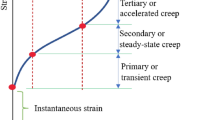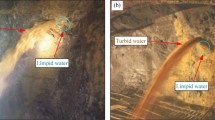Abstract
Providing a suitable protective water barrier pillar (PWBP) is common to reduce inundation hazards in underground coal mines. The imperative factors influencing its performance include the water head acting on the pillar, cover depth, pillar width, strength properties, and permeability characteristics. The mechanical failure of such pillar is a stress-controlled phenomenon, whereas the hydraulic failure is a strain-based phenomenon. A finite-difference numerical modeling approach was developed to study the hydro-mechanical coupled behavior of protective water barrier pillars. The mechanical stability was evaluated in terms of the percentage of failed (ZoF) and intact zones. The influence of the strain-controlled weakening on the permeability of the flow medium was studied through the coupling of the mechanical and hydraulic effects. The coupled steady-state model was used to estimate the outflow rate and its hydraulic stability. The adequacy of the protective pillar was also investigated by assessing mechanical stability and capability to resist hydraulic pressure against the maximum expected water head. A seepage rate-based classification system has also been proposed to evaluate the seepage potential and assess the hydraulic stability. The model has been validated for two case studies at the cover depth of 136–189.5 m and the existing pillar width of 16–42 m against the water head of 25–141 m.












Similar content being viewed by others
References
Yao B, Bai H, Zhang B (2012) Numerical simulation on the risk of roof water inrush in Wuyang Coal Mine. Int J Min Sci Technol 22:273–277. https://doi.org/10.1016/j.ijmst.2012.03.006
Galav A, Singh GSP, Sharma SK (2021) Design and performance of protective water barrier pillars for underground coal mines in India—a review. J Inst Eng India Ser D 102:539–547. https://doi.org/10.1007/s40033-021-00286-x
Job B (1987) Inrushes at British collieries: 1851 to 1970. Colliery Guardian;(United Kingdom) 235(5):192–199
Dash AK, Bhattacharjee RM, Paul PS (2016) Lessons learnt from Indian inundation disasters: an analysis of case studies. Int J Disaster Risk Reduction 20:93–102. https://doi.org/10.1016/j.ijdrr.2016.10.013
DGMS (2017) The coal mines regulations 2017, Dhanbad, India. p. 121.
DGMS (2003) Safety circulars, Technical circular no. 5, 2003, Dhanbad, India.
Singh RN, Atkins AS (1982) Design considerations for mine workings under accumulations of water. Mine Water Environ 1:35–56. https://doi.org/10.1007/BF02504586
Luo Y, Peng S, Zhang Y (2001) Simulation of water seepage through and stability of coal mine barrier pillars. Trans North Am Manuf Res Inst of SME 310:142–147
Chen L, Feng X, Xie W, Zeng W, Zheng Z (2017) Using a fluid–solid coupled numerical simulation to determine a suitable size for barrier pillars when mining shallow coal seams beneath an unconsolidated, confined aquifer. Mine Water Environ 36:67–77. https://doi.org/10.1007/s10230-016-0404-6
Zhang Y, Li F (2022) Prediction of water inrush from coal seam floors based on the effective barrier thickness. Mine Water Environ 41:168–175. https://doi.org/10.1007/s10230-022-00846-x
Meng Z, Shi X, Li G (2016) Deformation, failure and permeability of coal-bearing strata during longwall mining. Eng Geol 208:69–80. https://doi.org/10.1016/j.enggeo.2016.04.029
Wang F, Liang N, Li G (2019) Damage and failure evolution mechanism for coal pillar dams affected by water immersion in underground reservoirs. Geofluids 2019:1–12. https://doi.org/10.1155/2019/2985691
Zhao J, Konietzky H, Herbst M, Morgenstern R (2021) Numerical simulation of flooding induced uplift for abandoned coal mines: simulation schemes and parameter sensitivity. Int J Coal Sci Technol 8:1238–1249. https://doi.org/10.1007/s40789-021-00465-x
Kendorski FS, Bunnell MD (2007) Design and performance of a longwall coal mine water-barrier pillar. 26th International Ground Control Conference in Mining 31 Jul - 2 Aug West Virginia University, U.S.A.
Zhang J, Wang J (2006) Coupled behavior of stress and permeability and its engineering applications Yanshilixue Yu GongchengXuebao/Chinese. J Rock Mech Eng 25:1981–1989
Kesserü Z (1982) Water barrier pillars. Proceedings of International Mine Water Association :91–117.
Zhu H, Zhao X, Guo J, Jin X, An F, Wang Y, Lai X (2015) Coupled flow-stress-damage simulation of deviated-wellbore fracturing in hard-rock. J Nat Gas Sci Eng 26:711–724. https://doi.org/10.1016/j.jngse.2015.07.007
Durucan S (1981) An investigation into the stress-permeability relationship of coals and flow patterns around working longwall faces. Dissertation , University of Nottingham, United Kingdom
Whittles DN, Lowndes IS, Kingman SW, Yates C, Jobling S (2006) Influence of geotechnical factors on gas flow experienced in a UK longwall coal mine panel. Int J Rock Mech Min Sci 43:369–387. https://doi.org/10.1016/j.ijrmms.2005.07.006
Ren TX, Edwards JS (2002) Goaf gas modeling techniques to maximize methane capture from surface gob wells. Mine Ventilation 2:79–86
Harlow GE Jr., LeCain GD (1993) Hydraulic characteristics of, and ground-water flow in coal-bearing rocks of Southwestern Virginia. Water Supply, U.S. Government Printing Office. paper no. 2388.
Dabbous MK, Reznik AA, Taber JJ, Fulton PF (1973) Permeability of coal to gas and water. Soc Petrol Eng J 14:563–572
Yang TH, Liu J, Zhu WC, Elsworth D, Tham LG, Tang CA (2007) A coupled flow-stress-damage model for groundwater outbursts from an underlying aquifer into mining excavations. Int J Rock Mech Min Sci 44:87–97. https://doi.org/10.1016/j.ijrmms.2006.04.012
Ministry of water resources government of India (2009) Ground water resource estimation methodology, Report of the ground water resource estimation committee, New Delhi, India. p. 133. http://cgwb.gov.in/Documents/GEC97.pdf . Accessed 15 December 2021.
Soni AK (2019) Mining of minerals and groundwater in India. In: Gomo M (ed) Groundwater—resource characterisation and management aspects. IntechOpen, London, p 146
Prusty B, Pal SK, Kumar JH (2015) Study of porosity and permeability of coal and coal measure rocks from Raniganj coalfield of India. Proceedings of the 24th International Mining Congress of Turkey, IMCET 2015:1024–1033.
Ghosh N (2011) Permeability of Indian coal. Dissertation, N.I.T. Rourkela, India.
Xue S (1989) Coal Permeability to the mixture of methane and carbon dioxide. Proc Aust Inst Min Metall 294(2):63–65
Esterhuizen G, Karacan C (2007) A methodology for determining gob permeability distributions and its application to reservoir modeling of coal mine longwalls. Society for Mining, Metallurgy, and Exploration. SME Annual Meeting and Exhibit, February 25–28, Denver, Colorado, Littleton, CO, pp 1–6. https://stacks.cdc.gov/view/cdc/8533/cdc_8533_DS1.pdf
Miller JT, Thompson DR (1974) Seepage and mine barrier width. Fifth Symposium on Coal Mine Drainage Research, Coal and Environmental Technical Conference, Louisville, Kentucky, National Coal Association :103–127.
Kissell FN, Bielicki RJ (1972) An in-situ diffusion parameter for the Pittsburgh and Pocahonate No. 3 coalbeds. United States Department of the Interior, U.S.A. 13.
ITASCA (2011) FLAC: Fast Lagrangian analysis of continua. Itasca Consulting Group Inc., Minneapolis. https://www.itascacg.com/software/FLAC
Singh GSP (2007) Cavability assessment and support load estimation for longwall workings in India. Dissertation, I.I.T. (ISM), Dhanbad, India.
Prassetyo SH, Irnawan MA, Simangunsong GM, Wattimena RK, Arif I, Rai MA (2019) New coal pillar strength formulae considering the effect of interface friction. Int J Rock Mech Min Sci 123:104102. https://doi.org/10.1016/j.ijrmms.2019.104102
Lönnies V (2017) Evaluation of pillar-roof interface and its effect on pillar stability in mine #101. Dissertation, Luleå University of Technology Department of Civil, Environmental and Natural Resources Engineering, Brazil. http://www.diva-portal.org/smash/get/diva2:1076054/FULLTEXT01.pdf
Rashed G, Peng SS (2015) Change of the mode of failure by interface friction and width-to-height ratio of coal specimens. J Rock Mech Geotech Eng 7:256–265. https://doi.org/10.1016/j.jrmge.2015.03.009
Walton G, Diederichs MS (2015) A new model for the dilation of brittle rocks based on laboratory compression test data with separate treatment of dilatancy mobilization and decay. Geotech Geol Eng 33:661–679. https://doi.org/10.1007/s10706-015-9849-9
Esterhuizen GS, Barczak TM (2006) Development of ground response curves for longwall tailgate support design, Proceedings, 41st U.S. Rock Mechanics Symposium, Golden, Colorado, June 17–21. Alexandria, VA: American Rock Mechanics Association, pp. 1–10.
Zhang G, Liang S, Tan Y, Xie F, Chen S, Jia H (2018) Numerical modeling for longwall pillar design: a case study from a typical longwall panel in China. J Geophys Eng 15:121–134. https://doi.org/10.1088/1742-2140/aa9ca4
Sheorey PR, Das MN, Barat D, Prasad RK, Singh B (1987) Coal pillar strength estimation from failed and stable cases. Int J Rock Mec Min Sci Geomech Abstr 24:347–355. https://doi.org/10.1016/0148-9062(87)92256-X
Das MN (1986) Influence of width/height ratio on post-failure behaviour of coal. Int J Min Geol Eng 4:79–87. https://doi.org/10.1007/BF01553759
Sheorey PR (1994) A theory for in situ stresses in isotropic and transverseley isotropic rock. Int J Rock Mech Min Sci Geomec Abstr 31:23–34. https://doi.org/10.1016/0148-9062(94)92312-4
Acknowledgements
The authors of this paper are grateful for the library service rendered by the Indian Institute of Technology (Banaras Hindu University), Varanasi, for this work. The authors express their gratitude to all the mines for their assistance.
Author information
Authors and Affiliations
Contributions
Conceptualization, methodology, software, data curation, writing—original draft preparation, visualization, investigation, validation: AG. Reviewing and editing: SKS. Supervision: GSPS.
Corresponding author
Ethics declarations
Conflict of Interest
The authors declare no competing interests.
Additional information
Publisher's Note
Springer Nature remains neutral with regard to jurisdictional claims in published maps and institutional affiliations.
Rights and permissions
Springer Nature or its licensor holds exclusive rights to this article under a publishing agreement with the author(s) or other rightsholder(s); author self-archiving of the accepted manuscript version of this article is solely governed by the terms of such publishing agreement and applicable law.
About this article
Cite this article
Galav, A., Singh, G.S.P. & Sharma, S.K. A Numerical Modeling Approach for Assessment of Seepage Characteristics and Performance of Protective Water Barrier Pillars in Underground Coal Mines. Mining, Metallurgy & Exploration 39, 2047–2063 (2022). https://doi.org/10.1007/s42461-022-00672-3
Received:
Accepted:
Published:
Issue Date:
DOI: https://doi.org/10.1007/s42461-022-00672-3




